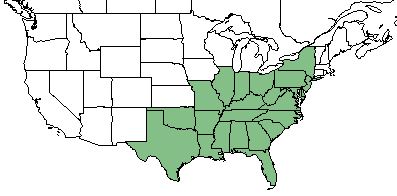Difference between revisions of "Quercus falcata"
(→Taxonomic Notes) |
(→Ecology) |
||
| Line 35: | Line 35: | ||
===Phenology=== <!--Timing off flowering, fruiting, seed dispersal, and environmental triggers. Cite PanFlora website if appropriate: http://www.gilnelson.com/PanFlora/ --> | ===Phenology=== <!--Timing off flowering, fruiting, seed dispersal, and environmental triggers. Cite PanFlora website if appropriate: http://www.gilnelson.com/PanFlora/ --> | ||
''Q. falcata'' flowers in March, April, and October. <ref name= "PanFlora"> PanFlora Author: Gil Nelson URL: [http://www.gilnelson.com/PanFlora/ http://www.gilnelson.com/PanFlora/] Date Accessed: 5/24/18 </ref> | ''Q. falcata'' flowers in March, April, and October. <ref name= "PanFlora"> PanFlora Author: Gil Nelson URL: [http://www.gilnelson.com/PanFlora/ http://www.gilnelson.com/PanFlora/] Date Accessed: 5/24/18 </ref> | ||
| − | + | ===Seed dispersal=== | |
| + | This species is thought to be dispersed by gravity. <ref> Kirkman, L. Katherine. Unpublished database of seed dispersal mode of plants found in Coastal Plain longleaf pine-grasslands of the Jones Ecological Research Center, Georgia.</ref> | ||
<!--===Seed bank and germination===--> | <!--===Seed bank and germination===--> | ||
===Fire ecology=== <!--Fire tolerance, fire dependence, adaptive fire responses--> | ===Fire ecology=== <!--Fire tolerance, fire dependence, adaptive fire responses--> | ||
Revision as of 15:23, 4 September 2018
Common name: Spanish oak [1], southern red oak [1]
| Quercus falcata | |
|---|---|

| |
| Photo by Dennis Girard hosted at Atlas of Florida Plants | |
| Scientific classification | |
| Kingdom: | Plantae |
| Division: | Magnoliophyta - Flowering plants |
| Class: | Magnoliopsida - Dicots |
| Order: | Fagales |
| Family: | Fagaceae |
| Genus: | Quercus |
| Species: | Q. falcata |
| Binomial name | |
| Quercus falcata Michx. | |

| |
| Natural range of Quercus falcata from USDA NRCS Plants Database | |
Contents
Taxonomic Notes
Synonyms: Quercus falcata var. falcata; Q. falcata var. triloba (Michaux) Nuttall; Q. digitata Sudworth; Q. triloba Michaux
Varieties: none
Description
Q. falcata is a perennial tree of the Fagaceae family native to North America. [2]
Distribution
Q. falcata is found in the southeastern corner of the United States from Texas to New York. [2]
Ecology
Habitat
Q. falcata proliferates in upland forests, usually xeric or submesic, but occasionally in mesic situations. [1] Specimens have been collected from dry sandy soil, pasture, second growth upland mixed woodland, mixed hardwood, open pine-oak-hickorym dry sandy loam, upland old field, and near edge of bluff. [3]
Phenology
Q. falcata flowers in March, April, and October. [4]
Seed dispersal
This species is thought to be dispersed by gravity. [5]
Fire ecology
Q. falcata is not fire resistant and has low fire tolerance. [2]
Conservation and Management
Q. falcata is listed as threatened by the Ohio Department of Natural Resources Division of Natural Areas and Preserves, and as endangered by the Pennsylvania Department of Conservation and Natural Resources. [2]
Cultivation and restoration
Photo Gallery
References and notes
- ↑ 1.0 1.1 1.2 Weakley, A. S. (2015). Flora of the Southern and Mid-Atlantic States. Chapel Hill, NC, University of North Carolina Herbarium.
- ↑ 2.0 2.1 2.2 2.3 USDA Plant Database https://plants.usda.gov/core/profile?symbol=QUFA
- ↑ URL: http://herbarium.bio.fsu.edu. Last accessed: June 2018. Collectors: Loran Anderson, Cecil Slaughter, R.K. Godfrey, W.D. Reese, H. Kurz, Kathy Craddock Burks, Patricia Elliot, R.F. Doren, Richard Mitchell, Celeste Baylor, Karen MacClendon, Daniel B. Ward, S.J. Ward, Kevin Oakes, Chris Cooksey, Palmer Kinser, Bob Farley. States and counties: Florida (Franklin, Marion, Jackson, Alachua, Leon, Wakulla, Washington, Okaloosa, Columbia, Liberty, Jefferson, Calhoun, Holmes, Nassau) South Carolina (Berkeley) Georgia (Brooks, Grady, Thomas) Alabama (Morgan)
- ↑ PanFlora Author: Gil Nelson URL: http://www.gilnelson.com/PanFlora/ Date Accessed: 5/24/18
- ↑ Kirkman, L. Katherine. Unpublished database of seed dispersal mode of plants found in Coastal Plain longleaf pine-grasslands of the Jones Ecological Research Center, Georgia.